Farm’s output approximately 10,000 metric tons
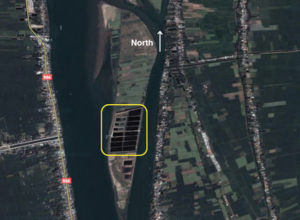
Compliance with Best Aquaculture Practices (BAP) certification standards typically involves modifications of production practices, but the effluent standards and restrictions on sediment disposal also often require modifications of farm infrastructure.
A case study is following changes in infrastructure at the QVD Aquaculture Pangasius farm near Tan Hoa, Dong Thap Province, Vietnam, in its efforts to achieve compliance with the BAP effluent and sediment standards.
Farm infrastructure, operation
The farm is situated on a small island in the Mekong River. The land on which the farm is sited was formerly in rice cultivation. The original layout of the farm consisted of 16 production ponds ranging from 0.56 to 0.95 ha in water surface area for a total area of 12 ha. Average pond depths vary from 3.0 to 3.8 meters, and the total volume of the production ponds is about 400,000 cubic meters.
A pumping station on the eastern side of the island discharges into a central water supply reservoir from which all ponds are supplied. Ponds on the eastern side of the farm discharge into a canal along the eastern border of the farm. This canal conveys water from ponds around the northern and southern perimeters of the farm, allowing all effluent to be discharged on the western side of the farm and thereby preventing contamination of river water near the pumping station.
Ponds are stocked at high density with a maximum standing crop of about 40 kg per square meter. The fish are fed twice daily with a commercial pelleted feed that contains 26 percent crude protein. Daily water exchange in ponds ranges from 20 percent pond volume at the beginning of a crop cycle up to 30 percent pond volume at maximum fish density.
Dissolved-oxygen concentrations in intake water are increased as a result of the turbulence introduced when water is pumped at high velocity up to 3 meters above the river level into the inlet aqueduct. Pond waters always have dissolved-oxygen concentrations of 4-7 mg/L, and mechanical aeration in ponds is not required.
Because of the intensive nature of the culture operation, sludge accumulates on pond bottoms and must be removed periodically. Sludge removal in each pond is accomplished at approximately three-week intervals using a small, boat-mounted dredge. The total amount of sludge and water removed each time is roughly 700 cubic meters per pond. The water and sludge from the dredge formerly were discharged into the river on the western side of the island.
By use of the procedures described above, the farm’s output of pangasius in 2010 was approximately 10,000 metric tons (MT) or about 833 MT/ha in 1.3 production batches. The feed-conversion ratio was about 1.7. Thus, in 2010, about 17,000 MT of feed containing around 707 MT of nitrogen and 170 MT of phosphorus were applied to the ponds. About 35 to 40 percent of the nitrogen and phosphorus applied in feed was recovered in the fish, while the remainder entered the water of the ponds or was contained in sludge that accumulated on pond bottoms.
The high density of fish favors resuspension of solids, which elevates concentrations of total suspended solids (TSS) and five-day biochemical oxygen demand (BOD5) in pond water. Thus, particular attention to the BAP concentration limits for nitrogen, phosphorus, TSS and BOD5 was necessary.
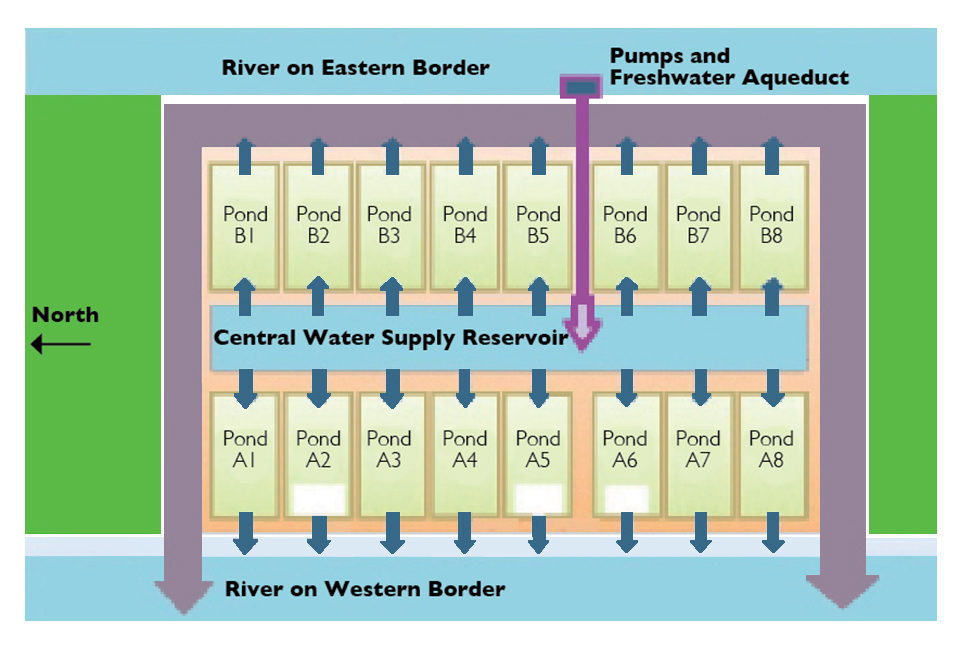
Modifications
The original farm infrastructure was compatible with BAP certification requirements on the eastern side of the farm. However, in preparing this part of the farm for BAP certification, the depth and width of the discharge canal were increased so that water flow is slow enough to allow sedimentation of suspended particles to occur before discharge back into the river. Weirs installed in the ends of the discharge canal to raise the water level cause the effluent to fall about 1 m to the level of the river. Gravity aeration at the weirs improves dissolved-oxygen concentrations in the effluent.
After the modifications described above, the discharge canal has a total water surface area of 1 ha and an average depth of 2 meters. At the maximum water exchange rate of 40 percent pond volume/day, the eight BAP-certified ponds (representing 5.5 ha surface area) release about 75,000 cubic meters per day into the discharge canal. Thus, the canal has a hydraulic retention time of 6.4 hours. This is adequate time for coarse solids to settle from the effluent. Of course, in the future, sediment removal from canals will probably be required to maintain adequate hydraulic retention for solids removal.
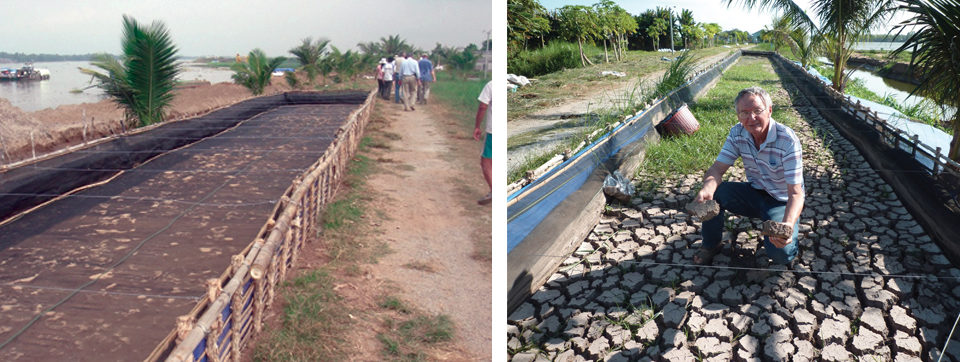
Beneficial aquatic plants
Floating, environmentally beneficial aquatic plants – mainly Chinese water spinach, Ipomoea aquatic; and water hyacinths, Eichhornia crassipes – grow profusely in the discharge canal. These plants remove considerable nitrogen and phosphorus from the water in their growth. Moreover, their roots extend into the water column, filtering out suspended particles and providing a substrate for growth of nitrifying bacteria. The plant roots serve both as mechanical and biological filters.
The farm should harvest these plants on a regular basis to encourage new growth and assure continued nutrient removal. Water spinach is an edible species in demand in Vietnam and other Southeast Asian countries, and it likely could be sold in local vegetable markets. Water hyacinth blossoms are edible, and the plants have been used as a source of fiber for making baskets and other handicrafts. Water hyacinths have been fed to cattle and hogs, but they have low nutritive value due to high moisture content.
Sludge disposal
To comply with BAP standards for sludge disposal, the dredge output had to be subjected to solids removal before entering the river. Direct discharge into the effluent canal was possible, but this would greatly accelerate the rate at which the canal filled with solids and possibly cause trouble in meeting the BAP standard for TSS concentrations. Thus, a structure for removing solids from dredge discharge was constructed on top of the pond embankments.
This structure – called a sludge pen here – is lined with a fine-mesh, geotextile material. The bottom is covered with a layer of sand. A second liner of fine mesh netting material covers the sand and the geotextile liner. The sludge pen filters nearly all of the coarse suspended solids from the dredge effluent, and the filtrate enters the discharge canals. It should be noted that the sludge pens in current use are temporary, and based on experience in operation of the prototype sludge pens, some improvements in design and efficiency for more permanent sludge pens are expected.
Solids retained in the sludge pens are allowed to dry. The fertilizer nutrient composition of the dry product compares quite favorably with that of traditional, organic manure (Table 1). It contains more nitrogen and phosphorus than dairy cattle manure does, and more phosphorus than found in steer and horse manure. Its potassium concentration is greater than that of traditional manures.
Boyd, Comparison of the plant nutrient, Table 1
| Material | Nitrogen (%) | Phosphorus (%) | Potassium (%) |
|---|---|---|---|
| Pangasius farm sludge | 0.49 | 0.45 | 1.25 |
| Chicken manure | 1.10 | 0.80 | 0.50 |
| Dairy cattle manure | 0.25 | 0.15 | 0.25 |
| Steer manure | 0.70 | 0.30 | 0.40 |
| Horse manure | 0.70 | 0.30 | 0.60 |
Although the organic matter content of the pangasius pond sludge was not measured, it undoubtedly has a higher organic matter concentration than that found in the highly leached, tropical soils of the Mekong Delta region. Thus, the sludge has value as an organic manure and soil amendment for use on agronomic or horticultural crops. The nutrient and organic matter content of the dry sludge probably could be increased by modifying the dredge to minimize intake of bottom soil underneath the layer of sediment.
Water quality
Water quality data from the BAP effluent-monitoring station are available for nine dates before modifications were made in the canal and for four dates after completion of the changes.
The modifications had little effect on pH and dissolved-oxygen concentrations (Table 2). However, there were large reductions in total ammonia nitrogen, BOD5 and TSS concentrations as a result of the modifications. The increase in soluble phosphorus concentration after the modifications does not seem logical and was likely the result of a single, exceptionally high and possibly erroneous measurement. It should be noted that the modifications used to achieve compliance with the BAP standards did not require reduction of fish production.
Boyd, Water quality variable concentrations, Table 2
| Variable | Before Average | Before Range | After Average | After Range | BAP Criteria |
|---|---|---|---|---|---|
| pH | 6.97 | 6.75-7.00 | 7.40 | 7.00-7.60 | 6.00-9.50 |
| Dissolved oxygen (mg/L) | 6.17 | 5.50-6.00 | 5.54 | 5.00-7.00 | > 4.00 |
| Soluble phosphorus (mg/L) | 0.16 | 0-0.43 | 0.47 | 0.25-1.00 | < 0.50 |
| Total ammonia nitrogen (mg/L) | 1.13 | 0.10-2.88 | 0.22 | 0.09-0.51 | < 5.00 |
| 5-day biochemical oxygen (mg/L) | 14.8 | 6.00-21.80 | 5.90 | 2.60-7.00 | < 50.00 |
| Total suspended solids (mg/L) | 89.2 | 40.00-137.00 | 25.60 | 17.00-33.20 | < 50.00 |
Current activities
The QVD farm is currently modifying infrastructure to achieve BAP certification for the ponds on the western side of the island. A canal being constructed to receive the effluent from these ponds will join the existing canal to form a single canal that will traverse the perimeter of the farm and enter a 5,000-square-meter settling basin.
Final discharge from the settling basin will enter the river from a single outfall on the eastern side of the farm. Additional sludge pens will be constructed to accommodate the sludge from the ponds on the western side of the farm. The pumping station will be moved to the western side, where water quality is better because of greater river flow.
(Editor’s Note: This article was originally published in the September/October 2011 print edition of the Global Aquaculture Advocate.)
Authors
-

Claude E. Boyd, Ph.D.
Department of Fisheries and Allied Aquacultures
Auburn University, Alabama 36849 USA[117,100,101,46,110,114,117,98,117,97,64,49,101,99,100,121,111,98]
-
Francois Rajts
EWOS Consultant
-
James Firth
QVD Aquaculture
Sadec Town, Vietnam
Tagged With
Related Posts
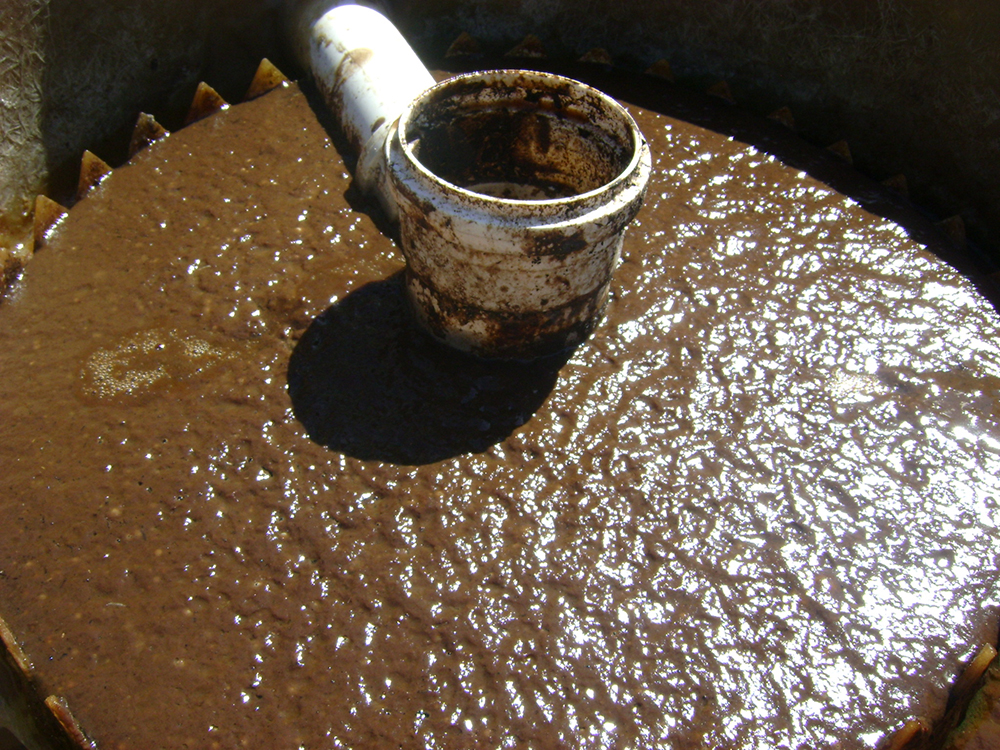
Aquafeeds
Crude protein and lipid from biofloc meals from an activated sludge system
A study compared the bioavailability of crude protein and lipid from biofloc meals generated with an activated sludge system using two water sources: wastewater from shrimp experimental culture (BFL-W) and, artificially, using clean seawater (BFL-C).

Health & Welfare
A holistic management approach to EMS
Early Mortality Syndrome has devastated farmed shrimp in Asia and Latin America. With better understanding of the pathogen and the development and improvement of novel strategies, shrimp farmers are now able to better manage the disease.

Responsibility
A look at various intensive shrimp farming systems in Asia
The impact of diseases led some Asian shrimp farming countries to develop biofloc and recirculation aquaculture system (RAS) production technologies. Treating incoming water for culture operations and wastewater treatment are biosecurity measures for disease prevention and control.
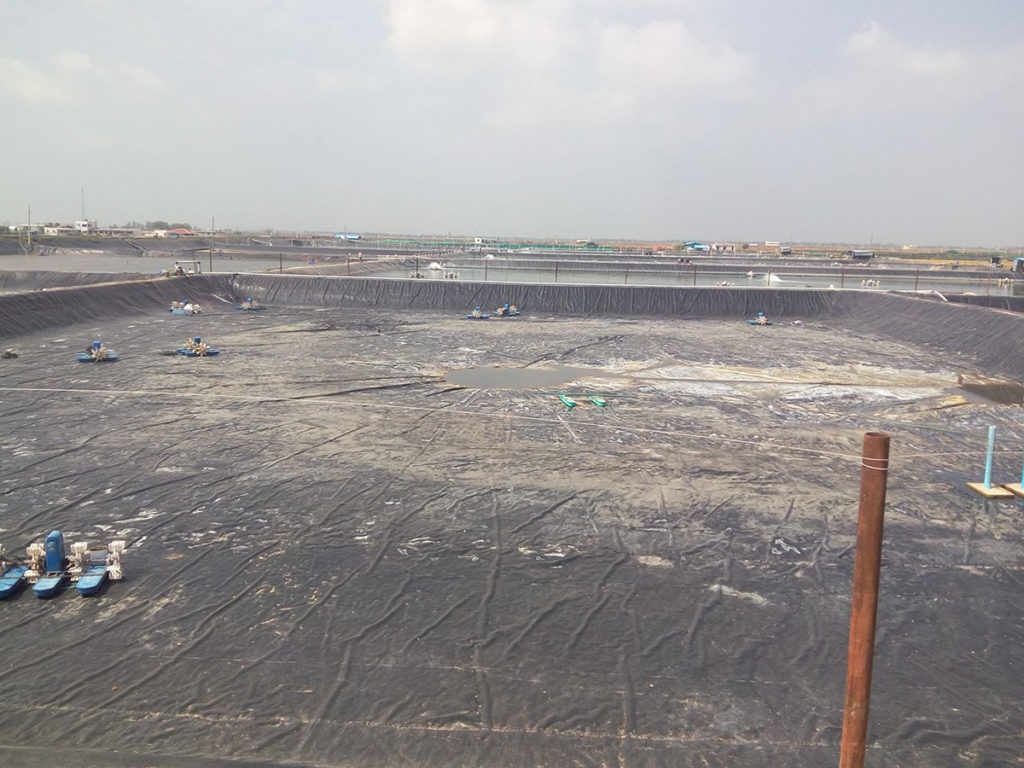
Responsibility
Appraising pond liners for shrimp culture
The use of plastic-lined ponds by shrimp farmers can significantly improve production efficiency, support more production cycles per year, and higher mechanical aeration rates and stocking densities. The capital cost of lining ponds can be very significant, so a thorough feasibility analysis is recommended when considering this production tool.


